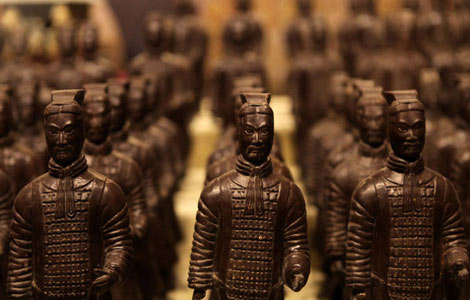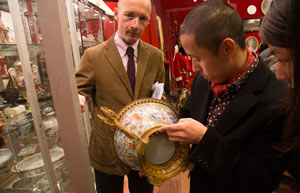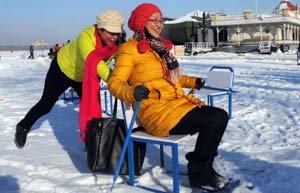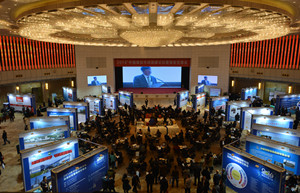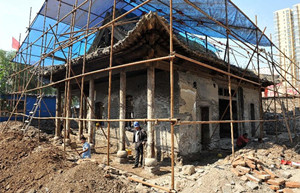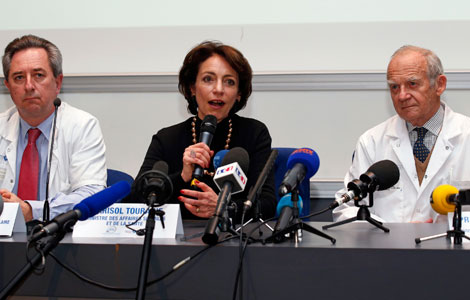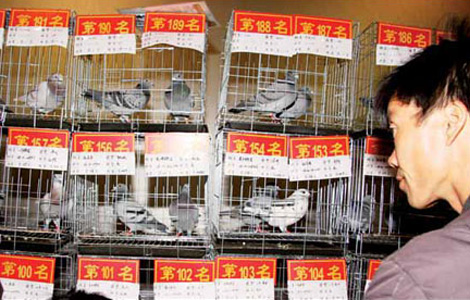Training seen as critical
By Li Xiang in Paris ( China Daily Europe ) Updated: 2013-12-20 10:00:41
'The new world is going to be an asian world,' says art education director
When Christie's Education closed its Paris branch in 2007 due to insufficient enrollments, Frederic Ballon, the then director of the international auction house's education arm in France, thought it was a shame as he believes education is an integral part of the art trade.
Ballon, the current director of the art training department at Drouot, one of the oldest French auction houses, says growing demand, especially from Asian students, and those from China, has given fresh impetus for art education in the more than $10 billion (7.4 billion euros) annual global art market.
The art market and the number of art professionals have been growing steadily in China, Ballon says. These professionals, he says, are keen to equip themselves with more information on the art trade and the cultural background on artworks.
"The art market has transformed profoundly, and the new world is going to be an Asian world," Ballon says. "Art education is becoming more and more important in countries such as China and India, where people are slowly waking up to the world of art."
Unlike big auction houses like Christie's, Drouot is a professional marketplace and service provider that brings together 74 auction houses in France. It has long been Europe-centric, with its main focus on the home market until the French authorities liberalized the French auction market in 2001 to allow international competition in the country.
Ballon's immediate goal is to attract more students from Asia to participate in Drouot's education program initiated in 2011 and to catch up with other international auction majors like Sotheby's and Christie's, which have already opened art training courses in China along with Chinese schools.
Courses at Drouot range from the history of contemporary art to Chinese imperial art and are offered by 80 professionals from different backgrounds including art dealers, historians, auctioneers and craftsmen.
Lectures on luxury sectors such as watch collections, jewelry design and wine culture are also included in the curriculum.
Ballon says that the one-year full-time rigorous and intensive course aims to equip students with "knowledge of the art market from A to Z".
The program enables students to arm themselves with knowledge gained from direct contact with art works, and also through field trips to meet art experts and artists at galleries, museums, and the back rooms of auction houses, to better understand the nuances for the high premium attached to some artworks.
However, the real focus of the program is to nurture entrepreneurship and train the students in practical business aspects, Ballon says.
"The program is designed more as a business school type course, rather than the theoretical and academic type courses offered at the Ecole du Louvre," he says. "I want my students to be more business oriented and to be able to launch their own company after graduation."
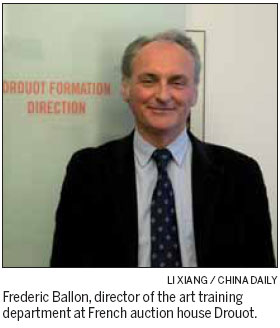
At present, Chinese students only account for a small percentage of the total enrollment at Durout's training program and Ballon hopes to attract more students by starting courses in English.
His next step is to bring the education program to other Asian cities such as Beijing, Shanghai and Mumbai and to compete with Christie's and Sotheby's, which have already entered the Chinese market.
In May, Christie's formed a partnership with China Europe International Business School, which allowed the auction house to bring its education program to the Chinese mainland.
The target students for the Christie's program are China's growing super-rich art collectors who want to hone their art-related knowledge. The price tag for these courses are steep, at about 200,000 yuan ($33,000; 24,000 euros) for the 10-day study and field trip course covering four cities - Beijing, Taipei, Hong Kong and London.
Unlike with Christie's, Ballon says, his program with a total cost of 9,200 euros seeks to train highly qualified art professionals and entrepreneurs who want to start their own businesses and hope to operate in the foreign markets.
"Students must come with projects in their minds. Diploma is not the most important requirement. It is past experiences, energy and vision that matters."
Ballon is also keen to change the typical French attitude toward art education, that one must be an art scholar or academic to work in the art market.
"The aim of the program is not to create historians. You don't have to be extremely knowledgeable about art history to be a good professional in the art market," he says.
"What is more important is the ability to generate business and form partnerships with the general big picture of the art world in mind."
The increasing role of new technology such as Internet in the art market is also emphasized in the program.
"The old idea used to be that the less the client knows the better it is for the business. But now it is exactly the opposite.
"We are in an art market where new technologies make everything transparent. And I want my students to be able to cope with and adapt to the new world."
lixiang@chinadaily.com.cn
(China Daily European Weekly 12/20/2013 page7)
|
|
|
|
|
|
|
|
European Weekly
 China taken on as building partner
China taken on as building partner
Meetings with central and Eastern European heads underline China's global roal.



